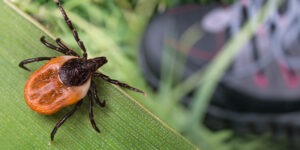Ticks: Behavior, Pest Control, and Prevention
Home and business owners are becoming more conscious of the need for tick pest control as cases of tickborne diseases continue to rise. Staying safe requires that you understand the dangers ticks pose, stay alert and aware in high-risk areas, and take action to implement preventative pest control measures.
What Are Ticks?
Ticks are tiny arachnids that feed on blood. Their primary food sources are mammals and birds, but they also feed from amphibians and reptiles. These small parasites spread easily and can infect their host through their bite. Ticks are dangerous not only because they are parasites but also because they are infamous for spreading dangerous diseases, like Lyme disease.
How to Identify Ticks
Ticks live in tall grasses, trees, and other foliage. They lie in wait until a host passes by and then latch on with their outstretched legs. Ticks come in a range of colors and sizes, but most share several identifying characteristics: they are flat, oval-shaped, and have four pairs of legs. Once they feed, the tick’s body swells up and may turn gray. Adults are normally the size of an apple seed, while larvae and nymphs can be as small as a grain of sand or a poppy seed. Some common species in the Carolinas include:
- American Dog Tick
- Black-Legged Tick
- Brown Dog Tick
- Gulf Coast Tick
- Lone Star Tick
Species of ticks vary by region. Learning how to identify common species and taking preventative measures can help reduce your risk of contracting a tickborne illness.
Impact of Ticks on Your Home or Business
These tiny pests can cause serious illness in both humans and pets. Lyme disease, perhaps the most infamous of the tick-borne ailments, has been detected in all 50 states and the number of diagnosed cases continues to increase. Other common illnesses passed through ticks include Rocky Mountain Spotted Fever, Rickettsia parkeri Rickettsiosis, Anaplasmosis, and Ehrlichiosis.
Most illnesses are easily treatable once diagnosed, but some tick-related diseases can have grave consequences if left untreated. Watch for common symptoms like rash, fever, headache, fatigue, and muscle aches. Consult your doctor if you’ve been bitten or suspect you may have a tick bite.

Tick Prevention Tips
Preventing ticks from becoming a problem is the best strategy for dealing with these pests.
Tick Prevention for Yours Family and Pets
Dress in long sleeves, long pants, shoes, and socks to keep ticks off your skin. Inspect your clothing and wash it in hot water or place it in the dryer on high heat for several minutes to kill any undiscovered ticks. Check yourself, your children, and your pets after spending time outdoors. Pay close attention to the backs of the knees, underarms, behind the ears, the groin, and in the hair.
Conduct a thorough check of your pet by feeling for small bumps and looking for dark-colored spots in their fur or against their skin. Speak with your vet about preventative tick treatments for your pet.
Ticks can transmit disease into the host’s bloodstream in as little as 24 to 48 hours of feeding after the bite. Staying aware and conducting a thorough check to remove any embedded ticks fast can help reduce your risk of becoming ill.
Tick Prevention for Your Yard
Keeping your outdoor spaces maintained is an effective way to reduce the risk of ticks:
- Keep the grass cut and trees, bushes, and other vegetation trimmed, especially around the property’s border to remove appealing tick habitats.
- Clear away fallen leaves and other yard refuse that ticks use for shelter.
- Consider building a fence around your property to deter wild animals that could carry ticks into your yard.
- Create a barrier around the edge of your property with wood chips or gravel to prevent migrating ticks from crossing.
- Clear away food and garbage and store it in sealed bins to prevent a rodent infestation that could bring ticks.
- Stack firewood off the ground and away from your home.
While these steps make it less likely that you’ll experience an infestation of ticks, it’s nearly impossible to eliminate the population without professional tick control. Killingsworth Environmental provides quality, state-of-the-art pest management service for ticks in the Carolinas to safeguard your home or business.
How to Get Rid of Ticks
Most ticks don’t carry disease, but there’s no way to know for sure without having it tested. Doing a tick check after outdoor activities so you can remove any that you find quickly can help lower your risks. It’s important to follow these steps for tick removal if you discover one on yourself or a pet:
- Use tweezers to grasp the head of the tick as close to the skin as possible.
- Avoid squeezing the body, which can increase the chances of the tick injecting its blood into the skin.
- Pull the tick straight out. Don’t twist; this can tear off the head and leave it embedded.
- Clean the bite area and wash your hands with soap and water.
- Dispose of the tick by wrapping it in tape or sealing it in a bag to prevent it from escaping.
Removing the tick and cleaning the bite is normally all the care you require. However, seek medical treatment if you develop a rash, fever, or other unexplained symptoms in the weeks following the tick bite.
Protect Your Home or Business with Professional Tick Treatment
A lot of people associate ticks with forests, hiking trails, and other remote outdoor environments. However, the reality is that ticks can survive nearly anywhere outdoors. Passing animals and overgrown foliage can both bring ticks into your space. They also frequently find their way indoors by latching onto a pet or clothing.
The ideal way to protect your home or business is with professional tick control from Killingsworth Environmental. We use the latest technology and treatments to safely protect your property so you can relax and enjoy being outside. Contact us today to learn more and to schedule a free quote.

